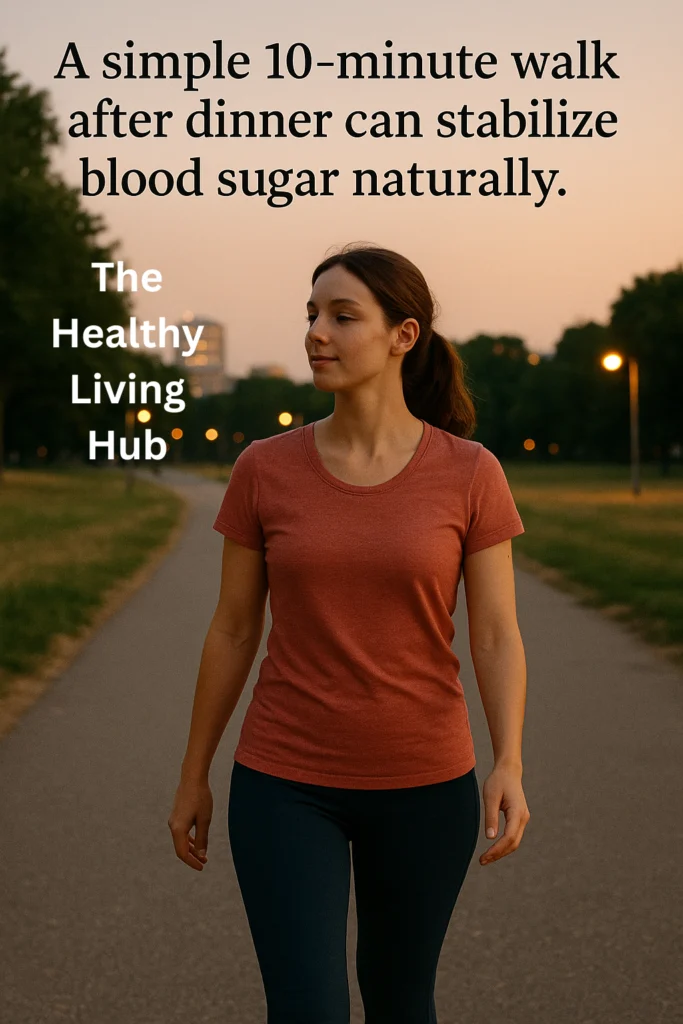Managing blood sugar doesn’t always require complicated diets or strict exercise plans. Sometimes, the simplest lifestyle tweaks deliver the biggest results. One such powerful yet underrated habit is the Post-Dinner Walk Blood Sugar routine. A short, relaxed walk after your evening meal can do wonders for your glucose levels, digestion, and long-term health — especially if you live in the US or UK, where sedentary evenings are common.
Daily life often involves long hours of sitting — at work, during commutes, or while watching TV. Over time, this lack of movement after meals can lead to dangerous blood sugar spikes, increasing the risk of type 2 diabetes and heart problems. But research now shows that just 10 minutes of gentle walking after dinner can significantly reduce these spikes, making it one of the easiest habits to adopt for better health.

Why Blood Sugar Spikes After Dinner Matter
Evening meals often contain the day’s heaviest carbohydrates — from rice, pasta, and bread to desserts and sugary drinks. After you eat, your blood sugar naturally rises. However, when you stay seated for hours afterward, your body struggles to manage this sudden glucose load, leading to spikes that can damage blood vessels, increase inflammation, and contribute to insulin resistance.
In both the US and UK, rising rates of prediabetes and type 2 diabetes have been closely linked to post-meal inactivity. High post-dinner glucose levels can also affect sleep quality, energy levels, and weight management. Fortunately, you don’t need to overhaul your entire lifestyle to address this — a small change can make a big impact.
The 10-Minute Post-Dinner Walk Routine
The concept is simple: within 20–30 minutes after finishing your evening meal, put on comfortable shoes and go for a 10-minute walk. This short stroll helps your muscles absorb circulating glucose, reducing the amount that remains in your bloodstream. It’s not about intense exercise — it’s about timing and consistency.
This routine works for people of all fitness levels. Whether you walk indoors on a treadmill, step outside in your neighborhood, or do gentle laps in your garden, the goal is light, consistent movement after eating.
How Post-Dinner Walks Help Regulate Blood Sugar
Walking after dinner lowers blood sugar through multiple mechanisms:
Improved glucose uptake: Your muscles act like sponges, pulling glucose from the bloodstream and using it for energy.
Better insulin sensitivity: Regular post-meal walking can improve how your cells respond to insulin, reducing the risk of resistance.
Enhanced digestion: Movement stimulates your digestive system, helping food move smoothly through the gut.
Reduced glucose peaks: Even short bouts of walking can flatten dangerous post-meal spikes.
According to the National Institutes of Health (NIH), post-meal activity can improve glucose control, especially in people with prediabetes and type 2 diabetes. Similarly, NHS guidelines encourage gentle movement after meals as part of healthy lifestyle habits.
Ideal Duration and Timing for Maximum Benefit
For most adults, 10 minutes is enough to make a noticeable difference. The key is to start walking within 20–30 minutes after finishing your meal, when blood sugar typically begins to rise. Evening walks are especially beneficial because they target the post-dinner spike, which tends to be the highest of the day.
If you have more time, extending your walk to 15–20 minutes can provide additional benefits, including better digestion and improved sleep. However, consistency matters more than duration. A short daily walk is more effective than a long walk once a week.
Who Can Benefit from Post-Dinner Walks
Almost everyone can benefit, but the Post-Dinner Walk Blood Sugar habit is especially useful for:
People with prediabetes or insulin resistance
Those managing type 2 diabetes
Individuals aiming to lose weight without intense workouts
Older adults looking for gentle activity
Office workers or anyone with a sedentary lifestyle
It’s also a family-friendly activity. Couples, children, or older relatives can join in, turning a health routine into quality bonding time.
Additional Health Benefits Beyond Blood Sugar
While the main goal is glucose control, post-dinner walks come with several bonus advantages:
Better sleep: Light evening activity can reduce restlessness and improve sleep quality.
Digestive comfort: Walking may ease bloating, gas, or heaviness after large meals.
Heart health: Regular movement helps maintain healthy cholesterol and blood pressure levels.
Weight management: Walking after dinner burns calories and prevents excess energy from being stored as fat.
Mental well-being: Evening strolls offer a calm break from screens, helping lower stress.
These combined effects make this simple habit a powerful tool for overall health and longevity.
Common Myths About Evening Walks
“You need to walk for 30–60 minutes to see results.”
False. Even 10 minutes can significantly lower post-meal blood sugar levels.
“Only intense workouts work.”
Not true. Gentle walking at a conversational pace is often enough to trigger glucose uptake.
“Walking after meals causes cramps or discomfort.”
In reality, light movement aids digestion and usually feels better than sitting still.
“This habit only helps people with diabetes.”
Everyone benefits from stable blood sugar, not just those with a diagnosis.
Practical Tips to Make It a Daily Habit
Keep shoes ready: Make it easy to step out by placing comfortable shoes near the door.
Set a reminder: Use your phone to nudge yourself 20 minutes after dinner.
Walk with someone: A partner or friend adds accountability and makes it more enjoyable.
Choose a simple route: You don’t need a scenic park; even walking around your home works.
Track your progress: A simple step counter or smartwatch can motivate you to stay consistent.
If you live in colder climates like parts of the UK, consider indoor walking options — hallways, malls, or treadmills work perfectly well.
Combining Post-Dinner Walks with Other Healthy Habits
While Post-Dinner Walk Blood Sugar routines are powerful on their own, pairing them with other lifestyle habits can amplify the effect:
Balanced dinners: Include protein, fiber, and healthy fats to slow glucose release.
Regular meal timings: Consistency helps your body regulate insulin more effectively.
Hydration: A glass of water before or after walking supports digestion.
Mindful eating: Slowing down during meals reduces glucose surges.
Together, these small tweaks create a holistic routine that supports metabolic health.
Internal Resource for You
If you’re exploring simple lifestyle habits to manage blood sugar, check out our related article: Diet for Colorectal Cancer Prevention: Carrots and Sweet Potatoes Cut Risk by 40% — it’s packed with evidence-based tips for long-term health.
When to Consult Your Doctor
While walking after dinner is safe for most people, those with specific medical conditions (e.g., severe neuropathy, balance issues, or cardiovascular problems) should consult their healthcare provider before starting any new routine. Your doctor may personalize your walking duration, intensity, or timing to suit your needs.
Conclusion: A Simple Habit with Big Results
Sometimes, lasting health improvements don’t come from extreme diets or punishing workouts — they come from simple, sustainable habits. The Post-Dinner Walk Blood Sugar routine is one of those habits. Just 10 minutes of gentle walking after your evening meal can stabilize your blood sugar, support digestion, and boost your overall well-being.
Start today. Lace up your shoes after dinner, step outside, and take that small but powerful walk. Your future self will thank you.
Image Information
Image Name: post-dinner-walk-blood-sugar.jpg
Alternative Text: Adults taking a post-dinner walk to manage blood sugar
Title: Post-Dinner Walk Blood Sugar Routine
Caption: A simple 10-minute evening walk can keep blood sugar in check.
Description: Realistic image of adults walking after dinner in a warm, evening setting, symbolizing healthy lifestyle habits.
References

